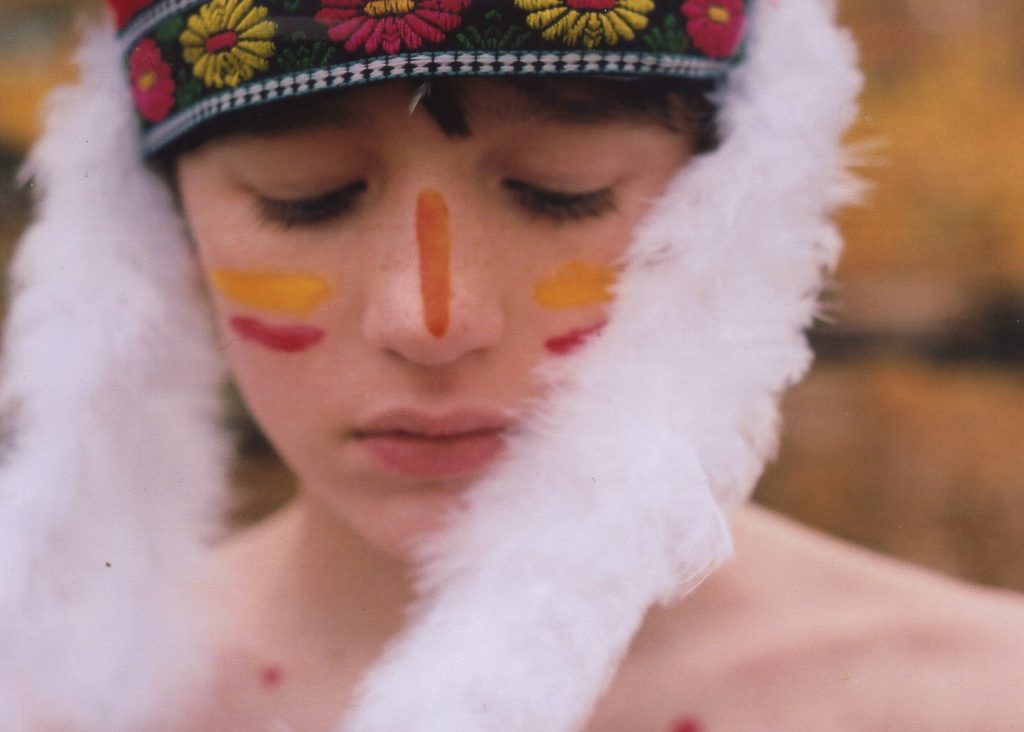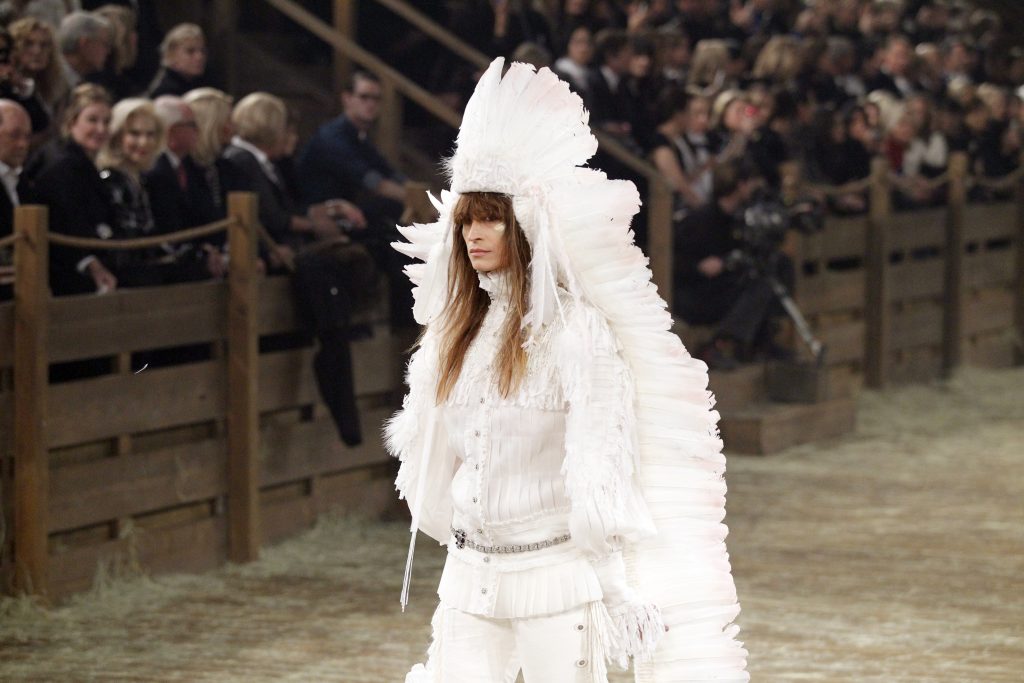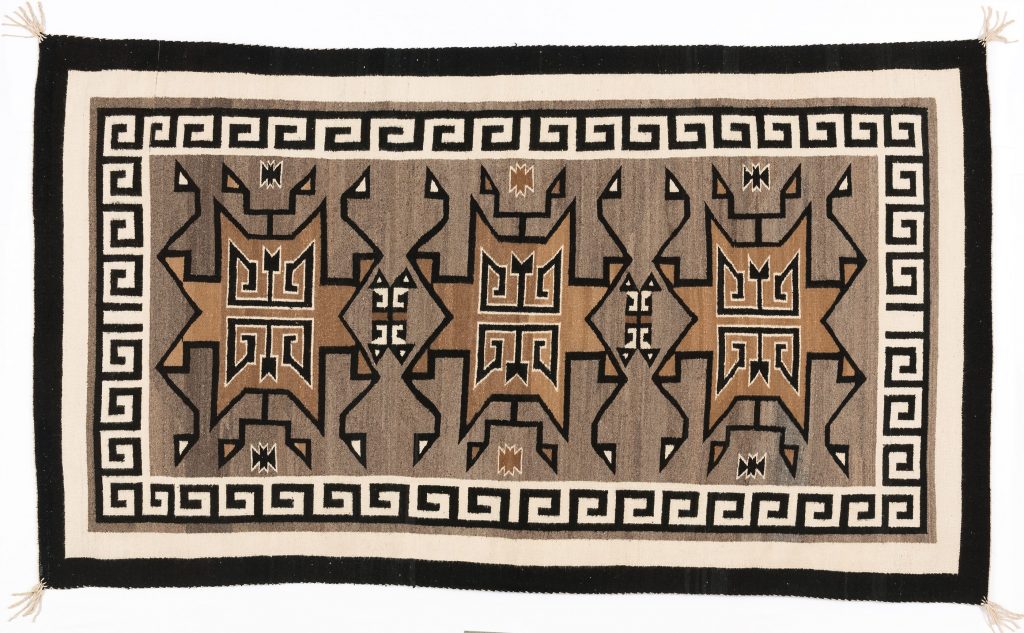Native by Design

In March 2016, Denver, Colorado, hosted its third annual Native Fashion in the City, a playful and high-energy fashion show. Seven designers from Native American tribal communities showcased their collections, blending urban street style with their own cultural themes and designs. Sleek pencil skirts, structured dresses with bold geometric designs, slouchy graphic T-shirts, and denim patchwork jackets challenged popular media stereotypes about what Native American art should look like, as well as how Native people should dress and who should model the clothes they design.
For years, waiflike, non-Native women adorned in Native-inspired prints and accessories have graced magazine covers and strutted down New York and Paris runways. To add insult to injury, the fashion industry has also largely played on Hollywood depictions of Plains Indians adorned in buckskin and feathers. It has excluded contemporary Native peoples and styles from the mainstream. Native Fashion in the City is attempting to change that by putting Indigenous models into designs made by tribal people. And it’s just one effort in a larger movement among Indigenous artists to highlight, redefine, and reclaim Native art.
These artists challenge the tendency in American culture to romanticize Native people—an attitude that can be traced back to the accounts of writers, explorers, and government officials from the 17th century. Observers grouped tribally specific traditions and objects—such as the designs found on Lakota Sioux moccasins or the painted jars made by Tewa potters—into a single generic category labeled “Native art” that fed stereotypes about Indigenous peoples and their creations. Such stereotypes concealed diversity and also fixed people in time: When many Americans think about Native peoples, they often picture something like George Catlin’s 1832 painting of a Blackfoot/Kainai chief rather than a more modern image. A new generation of Indigenous artists is drawing on personal experience and tribal traditions to counter the public’s preconceptions about the subject and style of Native art.
Despite these efforts to raise public awareness about contemporary Native people and traditions, generalizations about what constitutes “Native art,” and unethical assumptions about who has the right to produce or imitate it, persist in mainstream American culture. Over the past several years, Indigenous artists and community members have grown increasingly indignant over the widespread appropriation of Native designs. Chanel’s Paris-Dallas Métiers d’Art show featuring their pre-fall 2014 collection was set to a cowboy and Indian theme, complete with a slew of cowboy boots, 10-gallon hats, and Native American–inspired prints, beadwork, and feathered headdresses. Indigenous people and their allies critiqued the brand’s appropriation of Native fashion and accused the show’s designers and models of racial insensitivity. Chanel representatives eventually offered a disappointing sorry-but-not-sorry response, claiming that the show was intended to honor and celebrate Texas’ rich Indigenous heritage.
Perhaps the most publicized case of cultural appropriation in recent years was a dispute between the Navajo Nation and Urban Outfitters, a clothing company based in Philadelphia, Pennsylvania. As early as 2001, Urban Outfitters began using the Navajo name in association with underwear, jackets, flasks, and purses, all of which were adorned with geometric prints inspired by traditional Navajo crafts.
In 2012, the Navajo Nation sued the company for violating the Indian Arts and Crafts Act, a truth-in-advertising law passed in 1990 that prohibits misrepresenting any art or craft as Native-made when it is not. The act was intended to enhance the economic welfare of Native artists by promoting the development and expansion of a Native American arts market. Urban Outfitters responded with the claim that the term “Navajo” refers to a general style or design and is therefore available for anyone to use. A federal judge in New Mexico disagreed. In March 2016, he ruled in favor of the Navajo Nation, clearing the way for the tribe to seek damages. The case came to a close in September 2016, when the two parties signed a settlement agreeing to pay their own legal fees and to collaborate on the production and marketing of Navajo products.
Urban Outfitters’ assertion that “Navajo” is a generic term disregarded the fact that Navajos are a real group of people with their own political system and culture—not a brand. Furthermore, the company’s initial approach ignored the diversity, meaning, and importance of designs for Navajos and, by extension, many other tribal communities.
Native designs communicate tribal, familial, and individual identities and beliefs. “Design elements hold interpretation for each family and do not hold one universal meaning,” states Navajo tribal member Lynda Teller Pete in an upcoming book on Navajo weaving called Weavers, Collectors, and Changing Markets: The Crane Collection of Navajo Textiles. One example of the deeply personal nature of tribal designs is the ch’ihónít’i, or “spirit line,” that many Navajo weavers incorporate into their rugs. It’s a small, thin line that runs from the central design area to the rug’s outer edge. The spirit line, also referred to as a “weaver’s pathway,” is described by Teller Pete as a connection between a work and the individual weaver’s energy, spirit, and creativity.
The weaver’s pathway is also linked to a larger cultural tradition based on a powerful teacher and helper, known in Navajo as Na’ashjé’ii Asdzáá (Spider Woman). The Navajo believe that she wove the world into existence, then taught Navajo women the art of weaving. “In the Teller family, it is our path to the next rug,” Teller Pete writes in the upcoming book. “In the tradition of Na’ashjé’ii Asdzáá, who wove her many webs, we leave our trail, and it connects us to our next weaving.” This is just one example of the rich cultural history associated with particular design elements that shows a clear relationship between oral history, cultural knowledge, and contemporary Native arts and crafts.
Urban Outfitters’ claim that there is something generic about Navajo designs is baseless. These designs may share a similar set of aesthetically pleasing characteristics, but they are also the weaver’s personal expressions. Some refer to tribal or familial histories. Others are sacred and not intended to be used outside of particular contexts. Many of the geometric motifs in Urban Outfitters’ line were inspired by Navajo weaving designs. And while there are no proprietary rights to the cross, diamond, triangle, and zigzag patterns the company used to decorate their “Truly madly deeply Navajo print tunic” and other items, it is unethical for a non-Native company to use and profit from tribal designs and names without the consent or collaboration of that tribal community.
As a nation built by immigrants, the United States has always been comprised of multiple ethnic groups, religious communities, and factions who hold unique cultural beliefs. At times the relationships among these different communities has been contentious, and the line between cultural appropriation and cultural exchange has often been blurry. Being inspired by other cultures is a natural outcome of living in a diverse society and an important part of the creative process involved in making art, music, dance, and fashion. But blurry lines do not mean that it’s right to remove art, clothing, jewelry, and other intellectual and cultural property from their original contexts without acknowledging where they came from, whom they represent, and the political and historical struggles of those groups.
Navigating the waters between respectful reference and insensitive borrowing comes down to one thing: collaboration. Collaboration requires companies and designers to do more than simply appreciate and borrow the aesthetics of another culture. It demands they engage in an active dialogue with the particular community or artist who is inspiring the work. A collaborative approach can take many forms, including advocating for the struggles faced by different ethnic communities or engaging in cooperative, creative enterprises and profit-sharing.
Read more from the archives: “Confronting the Specter of Cultural Appropriation.”
The notion that these parties should be collaborating with tribes when representing their cultures is not unprecedented. Indeed, a similar suggestion was made in 1969 by Native American scholar and activist Vine Deloria Jr., whose groundbreaking manifesto Custer Died for Your Sins scathingly criticized the exploitative practices of anthropologists and other Western scholars studying Native groups. Deloria’s critique set in motion a series of legal and ethical reforms, including the Native American Graves Protection and Repatriation Act (NAGPRA), which was passed by Congress in 1990. The law mandated that archaeologists, museums, and federal agencies consult with tribal communities when managing their material heritage. NAGPRA sets an important precedent for how to respectfully interact with tribal communities, whose rights have been systematically abused and ignored for centuries.
Although it is difficult to apply a legal framework like NAGPRA to corporations without reducing Native cultures to copyright-protected brands, there are mutual benefits to be gained from collaboration with tribal communities. For example, in 2013 the iconic American fashion brand Paul Frank collaborated with four different Indigenous artists to create a collection of bags, sunglasses, jewelry, and shirts. The partnership brought the issue of cultural appropriation to the attention of a wider audience while promoting the work of Native artists.
With the election of Donald Trump as president, the U.S. is embarking on a new phase in its history. In this climate, inflammatory rhetoric regarding protecting our borders against Mexicans, Muslims, and other so-called outsiders has heightened concerns about respecting the rights of the country’s many diverse communities. Considering this political backdrop, increasing the social pressure on companies and organizations to protect the cultural and intellectual property of minorities and historically disenfranchised people is not just a nice suggestion—it’s a moral imperative.



























